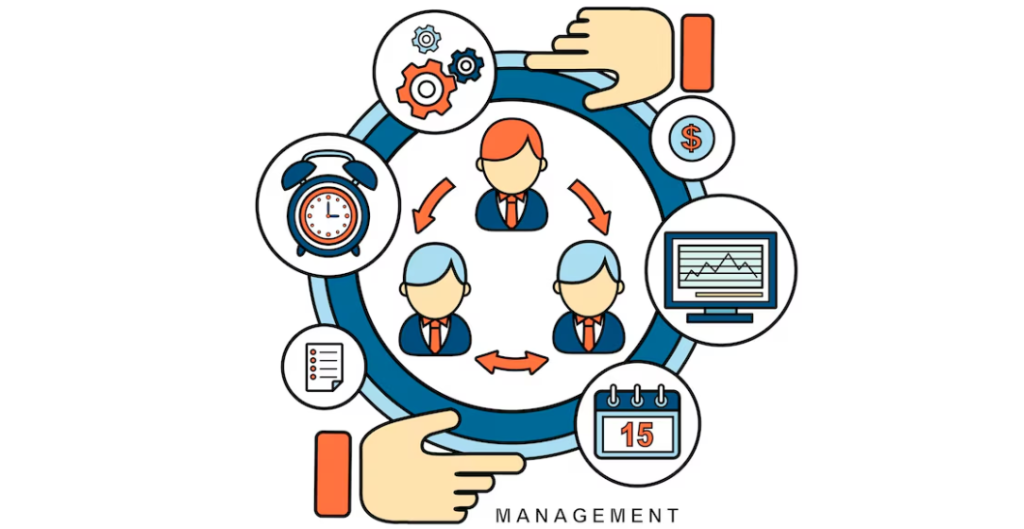
Table of Contents
Introduction
Let’s be real for a second — managing people at work can be… messy. One minute you’re onboarding someone new, the next you’re chasing timesheets or juggling a dozen spreadsheets just to run payroll. Exhausting, right?
That’s where an employee management system (or EMS for short) steps in like a quiet hero behind the scenes. It’s not just a fancy digital tool; it’s more like a smart assistant that keeps HR tasks flowing, employee info tidy, and your sanity somewhat intact.
These systems have grown beyond just tracking leave or uploading contracts. They’re here to support strategy, build transparency, and honestly, just help HR teams breathe a little easier. So, what’s the real intent behind adopting one? Let’s talk about that.
What Is the Intent Behind an Employee Management System?
Centralizing HR Functions and Employee Data
Picture this: all your HR stuff — documents, feedback, time-off requests — in one place. Sounds simple, but it’s a game-changer. The whole point of an employee management system is to centralize everything. No more searching five different folders or pinging three managers to find one performance review.
Using a solid hr manager software makes it way easier to access, update, and maintain employee data. Plus, having it all under one roof just feels more organized — like finally putting together that IKEA shelf you’ve been avoiding.
Enhancing Transparency and Accountability
We’ve all worked somewhere where no one knew how or why promotions happened. That lack of transparency? It crushes morale. EMS tools bring structure and visibility — you can actually see how people are performing and where they stand.
And guess what? Accountability flows both ways. Employees know what’s expected, and managers (well, the good ones) are held responsible for fair evaluations. It’s kind of refreshing.
Automating Repetitive Administrative Tasks
This part’s a lifesaver. An employee management system automates things like payroll, leave requests, and scheduling. And if you’re using hr and payroll software that syncs with EMS, it’s even better.
It’s not magic, but it sort of feels like it. Instead of manually calculating sick days or tracking attendance in Excel (ugh), everything runs smoothly in the background. You don’t even have to think about it. Bliss.
Supporting Strategic Decision-Making in HR
Here’s where it gets interesting. EMS platforms aren’t just for paperwork anymore. They’re packed with analytics that help HR actually drive business strategy.
Want to know who’s about to burn out? Who’s ready for a promotion? A good employee management system will tell you — often before you even ask. Especially if it includes a performance management system that tracks trends and flags issues early.
Core Objectives of an EMS
Improve Employee Engagement and Satisfaction
This might sound fluffy, but it’s not. Engaged employees stick around, work harder, and don’t ghost their managers. EMS tools offer feedback loops, recognition features, and even mood check-ins (yes, really).
It’s all part of building trust. And when employees feel heard, supported, and seen? They show up — in every way.
Streamline Onboarding and Offboarding
First days can be awkward. So can last days. A smart employee management system makes both less painful by creating clear, step-by-step processes for onboarding and offboarding. It feels a bit like giving someone a guided tour instead of just handing them the keys and wishing them luck.
One company I worked with used to email new hires ten separate forms. TEN. Switching to EMS changed everything — forms were automated, docs signed digitally, and people felt welcome before day one.
Ensure Regulatory Compliance
Okay, this part isn’t sexy, but it’s super important. Labor laws are always changing. EMS platforms — especially ones that double as workforce management software — help you stay on top of it all.
From contract renewals to mandatory training deadlines, compliance features keep your company out of hot water. So you can focus on people, not panic over audits.
Track Performance and Productivity
Let’s face it — no one enjoys the old-school annual performance review. But regular, meaningful feedback? That works. EMS platforms with a built-in performance management system help track goals, progress, and feedback all in one place.
And it’s not just about catching low performers — it’s about celebrating wins, spotting future leaders, and, you know, actually helping people grow.
Enable Data-Driven HR Management
This one gets me excited. Data is power. With EMS, you’re not guessing anymore. You’re using real numbers to guide hiring, training, retention — the whole HR shebang.
When you’ve got data at your fingertips, you start asking better questions. Like, why is turnover higher in one team? Are new hires staying long enough? That’s when an employee management system turns HR from a basic admin function into a true strategic powerhouse. With real-time insights and data-driven trends, decisions are no longer based on guesswork—they’re guided by what’s really happening on the ground.
Key Features That Align with EMS Intent
- Attendance and Time Tracking: Because nobody wants to argue over hours worked.
- Performance Management Modules: Clear goals, regular feedback, less awkward reviews.
- Payroll Integration: Syncs with your hr and payroll software to keep payday drama-free.
- Learning and Development Tracking: Helps you spot skills gaps and invest in growth.
- Employee Self-Service Portals: So employees can stop bugging HR for their payslips (please!).

Business Benefits of Aligning With EMS Intent
Improved HR Efficiency and Reduced Workload
Let’s not sugarcoat it — HR teams are often overwhelmed. But an employee management system clears that clutter. Processes become smoother, things get done faster, and fewer details slip through the cracks.
Honestly, it’s like upgrading from flip phone to smartphone.
Better Employee Experience and Retention
People notice when things run smoothly. From smooth onboarding to timely recognition, an employee management system supports positive experiences that help retain top talent. Nobody wants to stay at a company that still uses paper forms and sticky notes. An EMS brings structure, consistency, and a sense of professionalism that today’s workforce truly values.
Real-Time Insights and Analytics
EMS tools offer dashboards that tell you what’s working and what’s not. It’s like having a bird’s-eye view of your team’s energy, growth, and engagement — with actual data, not gut feelings.
Especially helpful when using workforce management software to plan ahead or make a case for hiring.
Scalability for Growing Teams
Whether you’ve got 10 people or 1,000, a good EMS can grow with you. It adjusts as your needs change — new locations, remote teams, different schedules. No need to start from scratch every time you grow.
Enhanced Communication and Collaboration
Better communication means fewer misunderstandings. EMS platforms often include chat, notifications, and company updates. And when everyone’s in sync? Everything feels just a bit less chaotic.
How Does VOffice Desk Support the EMS Intent, Simply and Smartly?
Let’s be honest — keeping track of the employee data, payroll, and onboarding can be a full-time job in its own right. That is where VOffice Desk comes into the picture and thickens an already-faced easier life.
Its all-in-one employee management system is meant to keep businesses orderly, save them time, and morally support their teams without any tech headache.
What it offers:
- Centralized HR Dashboard: All employee data, documents, and requests are located at one place. No more pulling out folders and spreadsheets.
- Time & Attendance Tracking: Works as a recording clock for work hours, time off, shifts, etc., so none of the records can be forgotten
- Payroll & Compliance Automation: Calculates, gives payslips, and deals with legal requirements while keeping things accurate and audit-ready on your end.
- Employee Self-Service: Helps employees look for info, request time off, or update their details without getting HR involved.
If you find yourself asking for a tool that actually understands the intent behind employee management systems — to keep things efficient, fair, and people-oriented — VOffice Desk is one you’d want to check out.
Real-World Use Cases: EMS in Action
Example 1: Small Business Using EMS for Payroll Automation
A local design firm I know made the jump to EMS after missing (another) payroll deadline. They integrated it with their hr and payroll software, and poof — no more errors, no more angry employees. Just smoother operations and a lot less stress.
Example 2: Mid-Sized Company Enhancing Team Performance
A growing SaaS company implemented a performance management system through their EMS. With regular feedback and clear goals, employees actually started looking forward to check-ins (seriously). Morale improved, and productivity went through the roof.
Example 3: Enterprise Leveraging EMS Data for Workforce Planning
A global retail brand used EMS data to identify seasonal trends and improve workforce planning. With better forecasting and analytics, they reduced turnover by 20% in just one year. Talk about impact.
Choosing the Right EMS for Your Organization
Picking the right system can feel overwhelming — so here’s a little checklist:
- Know your HR pain points. What’s not working?
- Decide if you want full hr manager software or something more specialized.
- Make sure it plays nice with your current tools.
- Think about scalability — can it grow with you?
- And don’t forget about support. You’ll need it eventually.
If you’re still stuck, take a peek at 🚀 this guide to top HR and payroll software by Entre — it breaks things down pretty nicely.
Future of Employee Management Systems
We’re not done evolving yet. Here’s where EMS is headed:
- AI-Powered Insights: Your EMS could soon predict resignations before they happen (creepy but cool).
- Hybrid Work Tools: From time zone tracking to remote onboarding — EMS is keeping up.
- Personalized Automation: Little things like nudges, birthday reminders, or suggested trainings. It all adds up.
So yeah, the future’s looking pretty smart.
Conclusion
The intent behind an employee management system isn’t just about making HR’s life easier — though that’s a huge plus. It’s about building systems that actually support the people within them. When done right, EMS becomes more than software — it becomes a strategic advantage.
Honestly, it took me a while to fully appreciate just how transformative a good EMS can be. But once you see the difference it makes — for HR, for employees, for leadership — it’s hard to imagine working without one.
Need help choosing one? Check out Entre’s software reviews. You might find exactly what you didn’t even know you needed.

